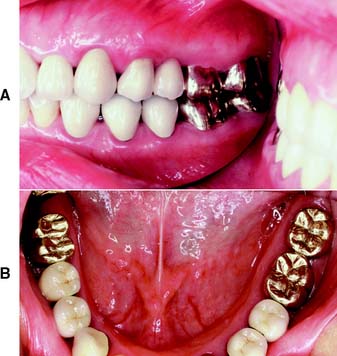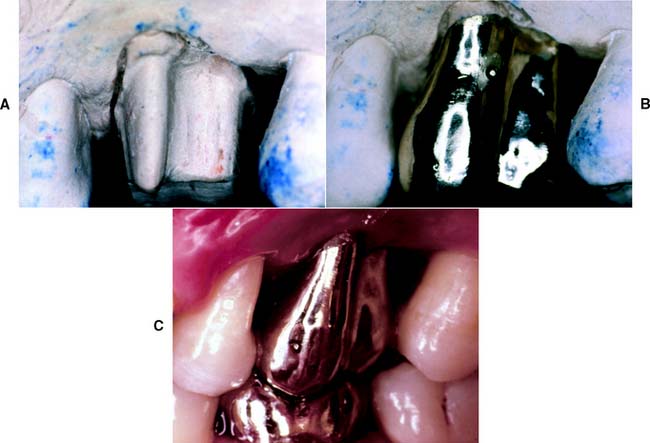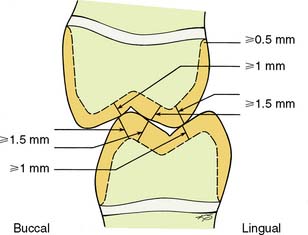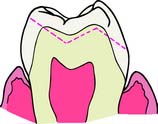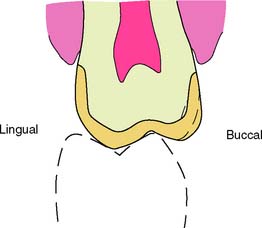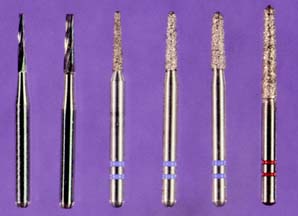8 THE COMPLETE CAST CROWN PREPARATION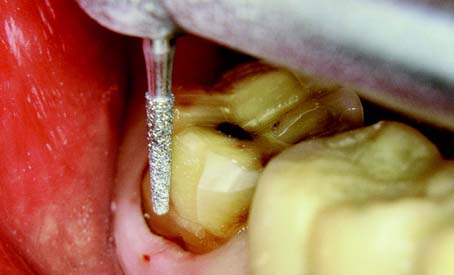
Although esthetic factors may limit its application, the all-metal complete cast crown should always be offered to patients requiring restoration for badly damaged posterior teeth. The complete cast crown has the best longevity of all fixed restorations. It can be used to rebuild a single tooth or as a retainer for a fixed dental prosthesis. It involves all axial walls, as well as the occlusal surface of the tooth being restored (Fig. 8-1).
ADVANTAGES
Because all axial surfaces of the tooth are included in the preparation, the complete cast crown has greater retention than a more conservative restoration on the same tooth (e.g., a seven-eighths or three-quarter crown [see Fig. 7-34]).
A complete cast crown allows the operator to modify axial tooth contour. This can be of special significance with malaligned teeth, although the extent of possible recontouring is limited by periodontal considerations. Similarly, it is possible to allow better access to furcations for improved patient oral hygiene through recontouring of buccal and lingual walls (Fig. 8-2). When special requirements exist for axial contours, such as when retainers are needed for partial removable dental prostheses, a complete crown is often the only restoration that allows the necessary modifications for the creation of properly shaped survey lines, guide planes, and occlusal rests (Fig. 8-3) (see Chapter 21).
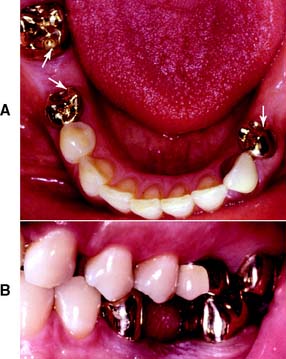
Fig. 8-3 Complete cast crowns used as retainers to accommodate a mandibular partial removable dental prosthesis. Metal-ceramic crowns have been placed on the mandibular left canine (A) and the maxillary first molar (B). Note the occlusal rests (A, arrows) and the survey contours (B), which extend to form reciprocating guide planes. (See Chapter 21.)
The restoration permits easy modification of the occlusion, which is often difficult to accomplish if a more conservative restoration is made. This is especially important when supraerupted teeth are present or when the occlusal plane needs to be reestablished.
INDICATIONS
This restoration is fabricated when correction of axial contours is not feasible with a more conservative technique. The restoration also may be used to support a partial removable dental prosthesis, because obtaining the necessary contours with a partial-coverage restoration is more difficult. Although proximal guide planes can sometimes be prepared through simple enamel modification, arriving at properly oriented reciprocal guide planes and survey contours is often impractical. The minimum dimensions required for occlusal rests of a partial removable dental prosthetic framework necessitate removing significant amounts of enamel and, if the dentin is exposed, restoring the tooth with a cast crown.*
CRITERIA
The margin should have a chamfer configuration and is ideally located supragingivally. Sometimes crown lengthening is indicated to obtain a supragingival margin, rather than risk future periodontal disease (see Chapter 6). The chamfer should be smooth and distinct and allow for approximately 0.5 mm of metal thickness at the margin. Typically, it is an exact replica of half the rotary instrument that was used to prepare it. (The recommended dimensions for reduction are shown in Fig. 8-4.)
Special Considerations
Functional (centric) cusp bevel
Proper tooth preparation for a complete cast crown results in the reduction’s being directly beneath the cusps of the crown (see Fig. 7-45). This is important for ensuring optimum restoration contour with maximum durability and conservation of tooth structure. Proper placement of the functional cusp bevel achieves this outcome. Because additional reduction is needed for the functional cusps (to provide 1.5 mm of occlusal clearance), the bevel must be angled flatter than the external surface (Fig. 8-5). On most teeth, the functional cusp bevel is placed at about 45 degrees to the long axis.
Nonfunctional (noncentric) cusp bevel
All complete crown preparations should be assessed for adequate reduction at the occlusoaxial line angles of the nonfunctional cusps. A minimum of 0.6 mm of clearance is needed here for adequate strength. Maxillary molars in particular often require an additional reduction bevel in this area (Fig. 8-6). Without it, an overcontoured restoration that does not follow normal configuration may result. Such additional reduction is often unnecessary for mandibular molars, however, because they are lingually inclined and their profile is relatively straight.
Stay updated, free dental videos. Join our Telegram channel

VIDEdental - Online dental courses


